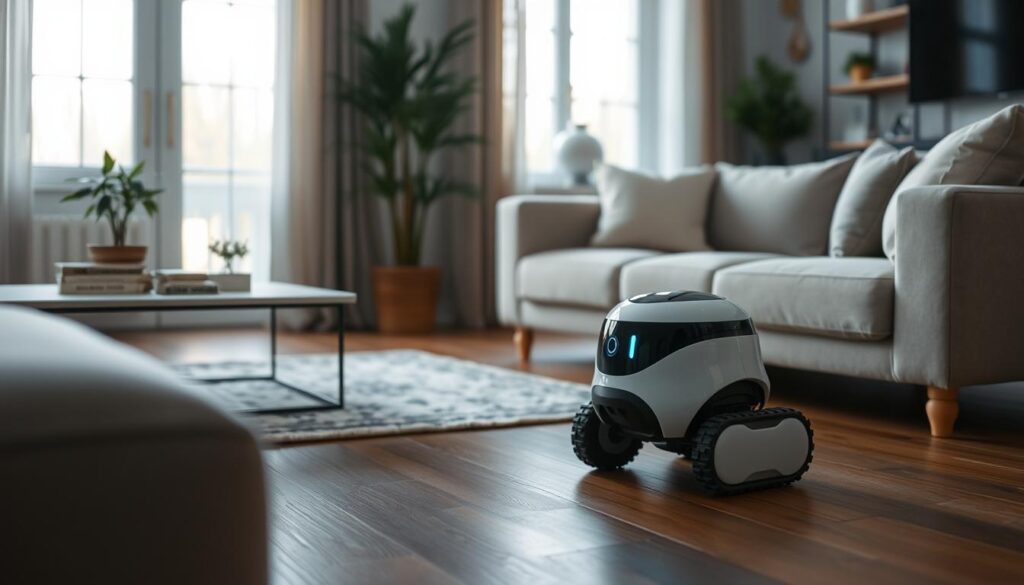Engineers use special algorithms to help home robots move around safely. These algorithms let robots detect and avoid obstacles. This is important for tasks like rescue work, patrolling, and handling materials.
There are different types of algorithms used. Some are sure and predictable, while others are more flexible and random. These methods help robots find their way and avoid getting stuck.
Robots use sensors and actuators to control their movements. This technology is key for robots to move around without bumping into things. It’s like how we use our senses to navigate the world.
Researchers have come up with many ways to help robots move. Some methods are global, like using maps and algorithms to plan paths. Others are local, using things like fuzzy logic and neural networks to make quick decisions.
These methods help robots move smoothly and safely. They also make robots smarter by adding features like voice recognition and AI assistants. This way, robots can understand and follow commands, making them more useful in our homes.
Introduction to Obstacle Avoidance in Home Robots
Obstacle avoidance is key for home robots to move safely and efficiently. They use sensor-actuator control to detect and avoid obstacles. This lets them do many tasks, like rescue work, patrolling, and helping in disasters.
Importance of Obstacle Avoidance
Good obstacle avoidance algorithms are vital for home robots to avoid hitting things. This keeps the robot safe and the area around it safe too. It also lets the robot move on its own, reliably and flexibly.
Applications of Home Robots
Home robots with obstacle avoidance can be used in many ways, including:
- Rescue operations: They can find and help people in emergency situations.
- Patrolling: They can check indoor areas for security threats or dangers.
- Disaster relief: They can help in disaster zones where people can’t go.
- Material handling: They can move and arrange objects safely, helping with cleaning or organizing.
Home robots use sensors and smart algorithms to navigate and avoid obstacles. This makes them more useful and capable in homes.

Sensor Technologies for Obstacle Detection
Home robots use different sensor technologies to avoid obstacles. These systems help them move safely and efficiently. They make sure the robots can go around things without bumping into them.
Ultrasonic Sensors
Ultrasonic sensors are key for detecting obstacles in home robots. They send out sound waves and measure how long it takes for them to bounce back. This tells the robot how far away objects are. Ultrasonic sensors work well indoors, no matter the light, because they’re reliable and affordable.
Infrared Sensors
Infrared (IR) sensors are also used in home robots. They send out infrared radiation and detect it when it bounces back. This helps them find and measure the distance to objects. IR sensors are great for detecting things up close and can help robots avoid obstacles.
Camera and Computer Vision
Camera sensors and computer vision are becoming more common in home robots. They help robots see and understand their surroundings. This lets them recognize objects, figure out their shapes and sizes, and decide how to move around them. This way, robots can avoid obstacles in real-time and know what’s going on around them.
| Sensor Technology | Obstacle Detection Capabilities | Key Applications |
|---|---|---|
| Ultrasonic Sensors | Measurement of distance to nearby objects | Indoor navigation, proximity sensing |
| Infrared Sensors | Sensing presence and proximity of objects | Close-range obstacle detection, edge sensing |
| Camera and Computer Vision | Object identification, classification, and distance estimation | Advanced obstacle avoidance, situational awareness |
Home robot development: Algorithms for Obstacle Avoidance
Home robots are becoming more common, and they need to avoid obstacles safely. Researchers have come up with new ways for these robots to move around without trouble.
Potential Field Methods
The potential field approach models the environment as a field. Obstacles push the robot away, while goals pull it towards them. This lets the robot find a safe path around obstacles.
Vector Field Histogram Approach
The Vector Field Histogram (VFH) uses a grid to map the robot’s area. It finds safe paths by looking for “valleys” in the grid. This method works well in changing environments.
Dynamic Window Approach
The Dynamic Window Approach (DWA) looks at the robot’s speed and movement limits. It picks the best speed to reach the goal without hitting anything. This makes the robot move safely and efficiently.
These new methods, along with better sensors and planning, help home robots move around better. They can do it safely and efficiently.

| Algorithm | Key Characteristics | Advantages |
|---|---|---|
| Potential Field Methods | Modeling the environment as an artificial potential field, with obstacles as repulsive forces and the goal as an attractive force. | Enables robots to plan collision-free paths by following the gradient of the potential field. |
| Vector Field Histogram Approach | Constructing a 2D histogram grid to represent the robot’s local environment and identify obstacle-free “valleys” for navigation. | Effective in dynamic environments, with the ability to respond quickly to changing conditions. |
| Dynamic Window Approach | Focusing on the robot’s kinematic and dynamic constraints to generate a set of feasible velocity commands for obstacle avoidance. | Produces optimal paths by considering the robot’s physical limitations and safety requirements. |
Integration with Navigation and Path Planning
In the world of home robot development, obstacle avoidance algorithms work hand in hand with navigation and path planning. They use global methods like Voronoi graphs and Dijkstra algorithms. At the same time, they use local techniques like potential fields and dynamic window approaches. This way, home robots can move smoothly and avoid collisions from start to finish.
The process of path integration, or dead reckoning, is key in navigation. It’s used by many animals and robots. But traditional robot navigation methods often struggle to adapt to different settings. That’s where autonomous mental development (AMD) comes in. It aims to make robots learn like humans and animals, improving their navigation skills.
New advancements in sensor control, trajectory planning, and autonomous navigation have made obstacle avoidance better. Tools like Orb-slam3 help improve navigation and path planning. Research on vision-based flight and dense 3D mapping also shows how well obstacle avoidance works in robotics.
As home robots get better, linking obstacle avoidance with navigation and path planning is key. This will help them move safely and reliably in homes and indoor spaces. With the latest in sensors, mapping, and algorithms, home robots can help us out more efficiently and safely.
Conclusion
The home robot market is growing fast. Now, making robots smart enough to avoid obstacles is key. They use sensors like ultrasonic and infrared to move safely around.
Algorithms help these robots find the best way to go. They can dodge things and do tasks without getting stuck. This makes them useful for cleaning, helping, and learning at home.
As robots get better, they’ll be more part of our homes. They’ll make our lives easier and more fun. The future looks bright for home robots and smart homes.

